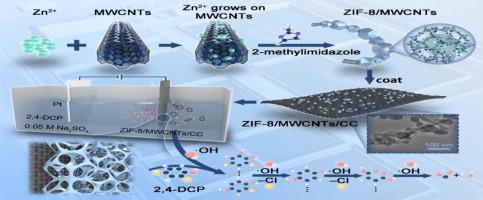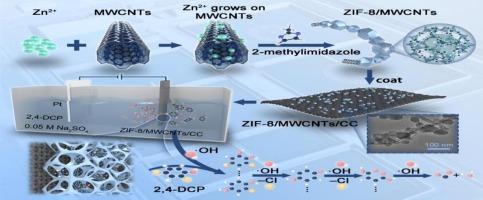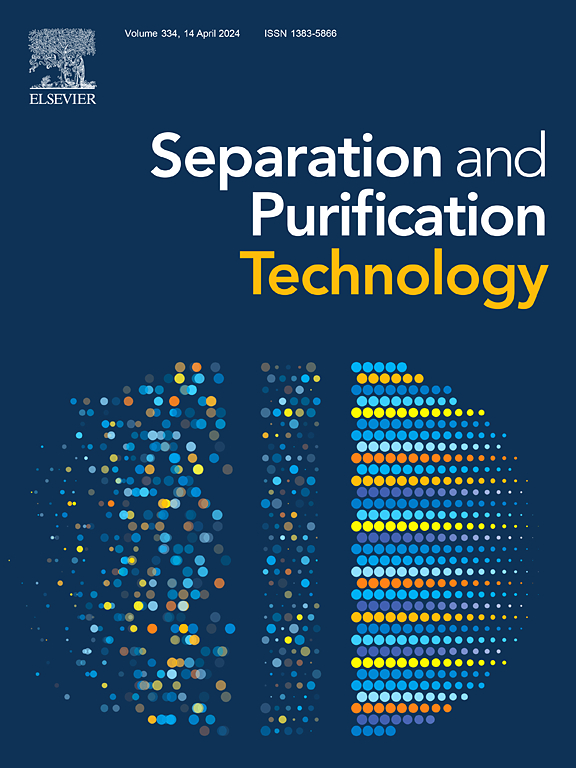ZIF-8/MWCNTs 纳米复合材料对 2,4-二氯苯酚的高效吸附-电化学降解性能研究
IF 8.1
1区 工程技术
Q1 ENGINEERING, CHEMICAL
引用次数: 0
摘要
2,4-DCP 是一种剧毒且难分解的有机污染物,常见于废水中。因此,研究高效去除废水中 2,4-DCP 的新技术至关重要。本研究采用一步合成法制备了具有明确介孔结构的 ZIF-8 / 多壁碳纳米管(ZIF-8/MWCNTs)纳米复合材料,随后将其涂覆到碳布(CC)上形成阳极 ZIF-8/MWCNTs/CC。随后,研究了 ZIF-8/MWCNTs 对 2,4-DCP 的吸附性能以及 ZIF-8/MWCNTs/CC 对 2,4-DCP 的吸附-电化学降解性能。ZIF-8/MWCNTs/CC 对 2,4-二氯丙醇表现出优异的吸附能力和吸附速率。在 303 K 的条件下,仅在达到平衡的 30 分钟内,其饱和吸附量就高达 1056.78 mg-g-1。此外,在 CC 基底上涂覆 ZIF-8/MWCNTs 时,其内部孔隙结构在吸附过程中得到了有效利用。此外,MWCNTs 的加入增强了 ZIF-8/MWCNTs/CC 电极的导电性,从而降低了电阻,提高了电子传输速率。值得注意的是,ZIF-8/MWCNTs/CC 能够在 90 分钟内完全去除 25 mg-L-1 的 2,4-DCP 溶液,在 120 分钟内完全去除 50 mg-L-1 的 2,4-DCP 溶液。此外,还通过 DFT 建模理论计算和中间产物测定分析,分析了 2,4-DCP 的降解机理,并对生成材料的毒性进行了评估。这项研究为处理废水中的氯酚类化合物污染提供了更好的解决方案和策略。本文章由计算机程序翻译,如有差异,请以英文原文为准。


Investigation of efficient adsorption-electrochemical degradation performance of ZIF-8/MWCNTs nanocomposites toward 2,4-dichlorophenol
The highly toxic and recalcitrant organic pollutant, 2,4-dichlorophenol (2,4-DCP), is commonly found in wastewater. Therefore, it is critical to investigate novel techniques for the efficient removal of 2,4-DCP from wastewater. The present study employed a one-step synthesis method to fabricate ZIF-8/multi-walled carbon nanotubes (ZIF-8/MWCNTs) nanocomposites with well-defined mesoporous structures, which were subsequently coated onto carbon cloth (CC) to form the anode ZIF-8/MWCNTs/CC. Subsequently, the adsorption performance of ZIF-8/MWCNTs toward 2,4-DCP and the adsorption-electrochemical degradation performance of ZIF-8/MWCNTs/CC toward 2,4-DCP were investigated. ZIF-8/MWCNTs exhibit exceptional adsorption capacity and rate toward the 2,4-DCP. At 303 K, it achieved a saturated adsorption amount as high as 1056.78 mg·g-1 within only 30 min of reaching equilibrium. Moreover, when coated on CC substrates, the internal pore structure of ZIF-8/MWCNTs is effectively exploited during the adsorption. In addition, the incorporation of MWCNTs enhances the conductivity of the ZIF-8/MWCNTs/CC electrodes, leading to reduced resistance and improved electron transfer rate. Notably, ZIF-8/MWCNTs/CC enabled complete removal of a 25 mg·L-1 solution of 2,4-DCP within only 90 min and a 50 mg·L-1 solution within 120 min. Furthermore, the degradation mechanism of 2,4-DCP was analyzed by means of DFT modeling theoretical calculations and intermediate product determination analysis, while evaluating the toxicity of the generated material was evaluated. This study provides improved solutions and strategies for the treatment of chlorophenolic compound pollution in wastewater.
求助全文
通过发布文献求助,成功后即可免费获取论文全文。
去求助
来源期刊

Separation and Purification Technology
工程技术-工程:化工
CiteScore
14.00
自引率
12.80%
发文量
2347
审稿时长
43 days
期刊介绍:
Separation and Purification Technology is a premier journal committed to sharing innovative methods for separation and purification in chemical and environmental engineering, encompassing both homogeneous solutions and heterogeneous mixtures. Our scope includes the separation and/or purification of liquids, vapors, and gases, as well as carbon capture and separation techniques. However, it's important to note that methods solely intended for analytical purposes are not within the scope of the journal. Additionally, disciplines such as soil science, polymer science, and metallurgy fall outside the purview of Separation and Purification Technology. Join us in advancing the field of separation and purification methods for sustainable solutions in chemical and environmental engineering.
 求助内容:
求助内容: 应助结果提醒方式:
应助结果提醒方式:


